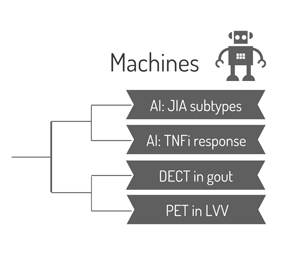 Editor’s note: RheumMadness is the place for everyone crazy about rheumatology to connect, collaborate, compete and learn together. During RheumMadness, rheumatology concepts represent teams that compete against each other in a tournament, much like basketball teams do in the NCAA’s March Madness tournament. In a series for The Rheumatologist, readers will get a chance to read the scouting reports for each concept team. These reports are written by rheumatology fellows from 13 programs throughout the U.S.
Editor’s note: RheumMadness is the place for everyone crazy about rheumatology to connect, collaborate, compete and learn together. During RheumMadness, rheumatology concepts represent teams that compete against each other in a tournament, much like basketball teams do in the NCAA’s March Madness tournament. In a series for The Rheumatologist, readers will get a chance to read the scouting reports for each concept team. These reports are written by rheumatology fellows from 13 programs throughout the U.S.
Don’t forget to submit your RheumMadness 2022 bracket by March 25. The more your picks match those of our Blue Ribbon Panel of rheumatologists, the more points you get. Learn more about the panel and how the brackets work online.
Connect with RheumMadness by subscribing to the podcast and joining the conversation on Twitter, #RheumMadness. Learn more on the RheumMadness website.
Region: Machines Team: AI: TNF Inhibitor Response
Machine learning, artificial intelligence (AI)—these phrases may spark images of Arnold Schwarzenegger as the time traveling AI from The Terminator. Thankfully, the machine learning we’re talking about is much more benign. Whew.
Briefly, machine learning is the concept that a computer system may be able to learn and adapt by using algorithms and statistical models to analyze data patterns and come to conclusions rather than being directly instructed. Thus, the machine learns by analyzing more and more examples—not hard and fast rules.
 Our base article by Tao et al. examines the use of machine learning to predict tumor necrosis factor inhibitor (TNFi) response in patients with rheumatoid arthritis (RA).1 In the management of RA, TNFi therapy is an often-used, step-up therapy from conventional synthetic disease-modifying anti-rheumatic drugs (DMARDs). Unfortunately, approximately 30% of patients do not respond well to initial TNFi therapy, and no clinical data exist to predict response status.
Our base article by Tao et al. examines the use of machine learning to predict tumor necrosis factor inhibitor (TNFi) response in patients with rheumatoid arthritis (RA).1 In the management of RA, TNFi therapy is an often-used, step-up therapy from conventional synthetic disease-modifying anti-rheumatic drugs (DMARDs). Unfortunately, approximately 30% of patients do not respond well to initial TNFi therapy, and no clinical data exist to predict response status.
The authors of this study sought to improve the rate of response to TNFi therapy by generating patterns of gene expression and DNA methylation in different immune cells in responders and non-responders to adalimumab and etanercept. By identifying differentially expressed genes and differentially methylated positions in the immune cells of responders and non-responders, the researchers created a machine learning model to accurately predict a patient’s response status.1
We leave the complexities of machine learning to Tao et al., but what we took away from this research was that differentially expressed genes and differentially methylated positions in immune cells can help differentiate between responders and non-responders to TNFi’s. Notably, little overlap between the differentially expressed genes and differentially methylated positions for adalimumab vs. etanercept responders exists. Machine learning can help predict a patient’s response to therapy and may also help uncover different mechanisms of action for these medications.
Implications
We believe the role of machine learning in medicine was best described by Rajkomar et al. in their New England Journal of Medicine article appropriately titled, “Machine Learning in Medicine.” They define machine learning not as a new tool, but a “fundamental technology required to meaningfully process data that exceed the capacity of the human brain to comprehend.”2
As rheumatologists, we use large amounts of clinical data to guide diagnostic and therapeutic decisions, but we still use anecdotal experience or trial and error to pick among between biologic treatments for patients with RA. As technology and understanding of deep molecular testing improve, we find ourselves with more data than ever. Machine learning can use this astronomical amount of data to predict responses to personalized treatment strategies.
In the case of Tao et al., this approach was used to predict treatment response to different TNFi’s. By entering a treatment decision with more certainty of response, the hope is to achieve more disease control up front and lower patients’ exposure to side effects and the costs of ineffective medications. This approach speaks to the idea of individualized medicine, with its goal of patient-specific care, to achieve better long-term outcomes.
Identifying unique signatures, such as these differentially expressed genes and differentially methylated positions, with the best predictive value across larger populations of patients with RA will be important to apply this machine learning model more broadly. Randomized controlled studies comparing traditional TNFi selection vs. this machine learning model should be considered. Other goals for research could include the identification of more unique differentiating signatures among responders and non-responders to medications for other rheumatic diseases.
Chances in the Tournament
Machine learning has unlimited potential. However, its complexities and lack of immediate applicability may make our team more of a dark horse than a front runner. Our most difficult competition may be our first-round competitor, AI: JIA Subtypes, as we take it on in a Battle-Bots style showdown. Other competitors we are wary of facing are Dalmatian Urate and Dog Osteoarthritis. Who doesn’t love man’s best friend?
We implore the Blue Ribbon panel to remember that although some may say that the art and nuance of medicine cannot be captured by a cold, unfeeling machine, AI: TNF Inhibitor Response is more of a collaboration than a Skynet-style takeover. In our base article, the processing capacity and algorithmic learning of our machine colleagues were shown to improve therapeutic response, removing some of the guesswork from our trial-and-error approach to prescribing TNFi therapy.
We feel we have the potential to be a fan favorite among Rheumies who are fed up with guessing what TNFi will work best for their patient. And unlike Arnold’s terminator, we believe we won’t be saying, “Hasta la vista,” early in the tournament.
Saja Almaaitah, MD, is a second-year rheumatology fellow in the Cleveland Clinic Foundation Rheumatology Fellowship program.
Shashank Cheemalavagu, MD, is a second-year rheumatology fellow in the Cleveland Clinic Foundation Rheumatology Fellowship program.
Rupal Shastri, MD, is a second-year rheumatology fellow in the Cleveland Clinic Foundation Rheumatology Fellowship program.
Perry Fuchs, MD, is a first-year rheumatology fellow in the Cleveland Clinic Foundation Rheumatology Fellowship program.
Melany Gonzalez Orta, MD, is a first-year rheumatology fellow in the Cleveland Clinic Foundation Rheumatology Fellowship program.
James Vondenberg, DO, is a first-year rheumatology fellow in the Cleveland Clinic Foundation Rheumatology Fellowship program.
References
- Tao W, Concepcion AN, Vianen M, et al. Multiomics and machine learning accurately predict clinical response to adalimumab and etanercept therapy in patients with rheumatoid arthritis. Arthritis Rheumatol. 2021 Feb;73(2):212–222.
- Rajkomar A, Dean J, Kohane I. Machine learning in medicine. N Engl J Med. 2019 Apr 4;380(14):1347–1358.
 Experience All of RheumMadness
Experience All of RheumMadness
During RheumMadness, rheumatology concepts represent teams that compete against each other in a tournament, much like basketball teams do in the NCAA’s March Madness tournament. In a series for The Rheumatologist, readers will get a chance to read the scouting reports. Check out the reports from each region:
Region: Cells
Region: Animal House
Region: Machines
Region: People
• False Positive MRI in Axial SpA
Don’t forget to submit your RheumMadness 2022 bracket by March 25. The winner of each match-up is decided by a seven-member Blue Ribbon Panel of rheumatologists. The panel will vote based on which topic they think is most important to patients, providers and researchers—both now and in the future. The more your picks match those of the panel, the more points you get. The tournament results will be released in four rounds from March 26–April 4. Prizes will be given to participants with the top scores in the following categories: 1) attending/APP, 2) fellow and 3) resident/medical student. The prize is a custom RheumMadness coffee mug and a lifetime of bragging rights.
Connect with RheumMadness by subscribing to the podcast and joining the conversation on Twitter, #RheumMadness. Learn on the RheumMadness website.



